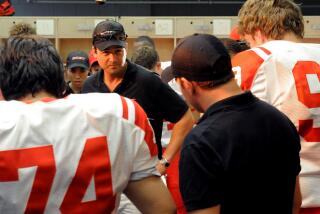Public Art: More Than a Pretty Distraction
As one of the five artists who worked on the first five Metropolitan Transportation Authority (Green Line) Stations administered by the Metro Art program, I would like to address some of the dissatisfaction expressed by art critic Christopher Knight in his article “How L.A. Missed the Train” (June 23).
Knight’s reaction to the MTA art brings up many points about public art that are not well understood. As an artist committed to art in public places for the past 20 years, I would like to share some experiences and hope to broaden the view of why we need public art in Los Angeles.
The Metro Art program began by providing a shared work space for five artists to design five stations on the Green Line. Our discussions and interactivity produced unanimous agreement that the artwork should be created for the repeat Metro Rail user--that is, the rider who goes to the same station every day and endures the boring wait there. By overloading the station with artwork content, these riders would, theoretically, continue to discover new aspects and details for many months and years.
Knight’s one-shot excursion to see all the artwork was not the intention of the art, and his reaction to it is the unfortunate result.
As Knight stated, L.A. is the home of a very sophisticated art community. At this time, most “successful” artists are connected to the art world based on gallery dealers and collectors who influence museum curators, who are influenced by art critics and historians, who write for magazines that sell ads back to galleries and museums.
It’s a somewhat hermetic industry, based on rich collectors with a predictable investment formula. An astute artist knows that a recognizable style or identity is important to “market” his or her work. Controversy, notoriety and outrageousness indirectly become a marketing tool, and the individual buyer accepts and supports this. The critic also supports this approach, as it provides ample intellectual writing opportunities to decipher the artist’s idiosyncratic vision.
The basic attitude this encourages for the artist is to promote his or her “cult of personality,” and to take a “me against them” (society) attitude. And the general public is turned off, as evidenced by our present low attendance for museums and galleries in Los Angeles.
Viewing art in the public environment is very different than in a museum or gallery. The well-meaning artwork is not sheltered by the context of the institution and is competing for attention with every piece of material junk, fake architecture, commercial decoration, false facade, screaming billboard and cheap construction that L.A., unfortunately, too often represents. Our eyes are conditioned to filter out everything in our urban environment or we get VUDS (visual ugliness depression syndrome). Sensitive personal statements by artists become overwhelmed by the visual glut.
Small wonder that Knight, perhaps a victim of VUDS, by now expects to see and only supports decoration in the public environment.
Artists working in public art today are at the forefront of a movement to reverse this situation.
For the public artist, the first requirement is that he or she must embrace the public and acknowledge the site even before creating the artwork. It becomes the context, and for me the inspiration, for the artwork. Countless “plop art” and “turds-in-the-square” artworks reveal what happens when an artist ignores this requirement.
*
Those of us who are committed to placing art in public places know that once the work is installed, it belongs to the site and to everyone. To the general public, who created the art is not important. The artwork must stand alone as part of the history and dynamics of the site. The art connoisseur and the homeless person have equal access--and the dreaded effects of human erosion (vandalism) must be accepted as just another process of nature.
For many gallery artists, used to the Art World construct, the public art process itself is a nightmare. A public artist is a contractor or vendor and must interface with other contractors who affect the outcome of the artwork. Reading architectural drawings, making design documents that must be approved by engineers, having some understanding of the process of architectural construction, etc., are basic requirements for most public art projects. Continual creative problem solving is also necessary to negotiate an artwork through the process.
But the rewards can be enormous. For me, overhearing ordinary citizens discussing what the art is about at my Metro station gratifies me more than I can verbalize. For today’s younger artists, making art that reaches beyond the present hermetic Art World addresses such basic questions as, “Who is my art for?” or “As an artist, why am I on Earth?”
L.A., one of the most technologically sophisticated areas on the planet, with a multicultural citizenry representing every country on Earth, has the potential to reset the concept of our materialistic world--from one of more and more to less but better. In the richest society in the world, we must appreciate and learn to respect the public world we have created. As with such issues as eliminating smog and making our oceans safe to swim in, this requires rewakening our awareness of our environment and what we are doing with it. What better way to start than by placing art in public places?
Carl Cheng, working as the John Doe Co., is a Santa Monica-based artist whose past local public art projects include the MTA’s Redondo/Marine Station and the “Santa Monica Art Tool” at the pier. His current projects are “Community Island Pond” in New York City and “Everglades Trespass” in South Florida.
More to Read
The biggest entertainment stories
Get our big stories about Hollywood, film, television, music, arts, culture and more right in your inbox as soon as they publish.
You may occasionally receive promotional content from the Los Angeles Times.






